Tips To Improve Your Catching Skills: You will need to be proficient at catching if you plan to play club cricket! Unfortunately, many cricketers are not gifted with the ability to catch a cricket ball. They may have a lot of awkward situations as a result in the field! When you have the chance to remove the top player on the other team, nobody wants to be the fielder who mishandles the ball!
Fortunately, we can all become better catchers by making sure we understand the fundamentals and working hard along the way! I’m going to give you 13 of my best-catching tips in this post. I can assure you that if you apply these suggestions, your game will improve quickly!
Here are my 13 tips for improving your cricket-catching abilities:
- Visualize The Shot A Batsman Might Play That Will Result In A Catch
- Make Sure You Regularly Take Part In Catching Drills
- Get Into A Balanced Position As The ball Is About To Be Bowled
- Keep Your Eye On The Ball
- Try To Improve Your Reaction Time
- Use The Orthodox Cup & Reverse Cup Catching Method
- Use The Hard Ball As Often As Possible In Your Practice Sessions
- Practice One-Handed Catches
- Get Positioned Underneath The High Ball As Quickly As Possible
- Use Your Hands To Soften The Blow From The Cricket Ball
- Remember To Wear The Right Headgear When The Sun Is Out!
- Develop A Way To Concentrate Your Mind Before Each Delivery
- Work On Boundary Catches With Your Teammates
Let’s now discuss these pointers in greater detail! Additionally, I’ll provide you with some practice drills that you may utilize right away to improve your catching abilities. Continue reading to locate those!
Visualize The Shot A Batsman Might Play That Will Result In A Catch
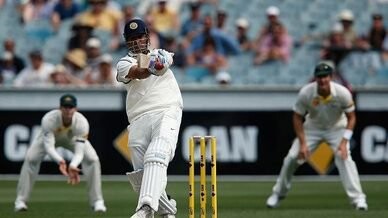
In cricket, I find that visualization is quite helpful when it comes to batting, bowling, and fielding.
Envisioning the kind of stroke a batsman may take to smash the ball at a catchable height in your direction might be helpful when fielding. Any ball that comes your way, for instance, is most likely the result of the batsman executing a cover drive if you are fielding at the cover position! It can help mentally prepare you for the catch you will have to make if you picture the batsman playing a lofted cover drive towards you.
My favorite thing to do is imagine the kind of ball the bowler needs to bowl and the body position the batsman needs to get into to knock the ball towards me! As the bowler gets closer to the crease, seeing this kind of stuff helps me maintain my focus on each ball, which is essential for a fielder. It also aids in bodily preparation for the catch you will need to make!
Naturally, a catch could appear to you very differently than the one you have in your mind, so you need to stay balanced and alert so you can respond to any shot the batsman takes!
Tips To Improve Your Catching Skills: Make Sure You Regularly Take Part In Catching Drills
The majority of cricket players are eager to dedicate a significant amount of time to honing their bowling and hitting strokes, but many are less eager to practice fielding! The amount of time professional cricket players spend on the practice ground is the reason they are such skilled fielders today!
You should practice catching as often at home as possible, in addition to adding drills to your club practices, if you want to grow better at it.
Here are a few drills to help you get better at catching.
High-Catching Drills
This one is easy! Ask a partner or the coach to hit or switch the ball as high into the air as they can. All you have to do is finish the catch and immediately toss the ball back to its original location! It is the best method for honing high catches because it accurately mimics a game scenario!
Close Catching Drills
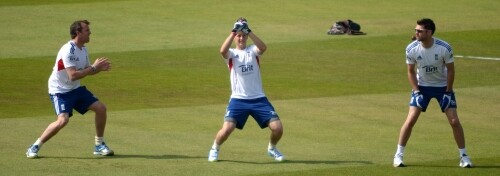
Your reactions will be put to the test with these drills! The ball will be approaching you considerably more quickly and near the ground. There are several methods available for achieving this:
Play Catch with a Partner: Get your partner to hurl the ball forcefully and quickly in your direction while you stand around five meters away. To make the catch, you’ll need to rapidly adjust your body to a crouch or balanced position and respond to the ball. To make the catching test more challenging, ask your partner to toss the ball in different directions toward different regions of your body. Throw the ball back to your buddy after you’ve caught it so they can try to catch it as well! I enjoy this exercise because it allows you to create small goals for yourself. My particular favorite is the 20-press-up requirement for the first person to drop a ball! That does offer some motivation, for sure!
Use a Katchet Training Aid With A Partner: Professionals always employ kitten training aids when practicing catching. These are little ramps that are set up on the ground a few feet in front of the individual wishing to practice catches. The ball should be thrown at the ramp by your teammate at various angles! This makes it difficult for you to catch the ball as it shoots off the ramp at various angles! In the same way, you may practice your batting with the Katchet training aid! As you try to strike the ball, have someone toss a ball onto the ramp about four to five meters away from the training aid! It gives your hitting drills a little more uncertainty, which is ideal if you want to replicate batting in hazardous situations!
Use a rebound net: You may practice close catches with rebound nets without the assistance of a partner or other people, which makes them fantastic! In essence, rebound nets are made of a net that is tightly coiled around a metal frame that can be adjusted. This implies that a ball fired at the net will accelerate its bounce off of it! Additionally, you can get the ball to bounce toward you at different angles because you can change the angle of the metal frame! When I was younger and had no one to practice with, I used these a lot, and they still hold today!
I used to pretend I was fielding in the slips for England, stand a few meters away from the net, toss the ball against it at an oblique angle, and then try to make an incredible catch!
Have a Partner Glance the Ball Off The Face Of The Bat: Professional teams frequently use this kind of drill, which is most effective when three to four individuals are trying to practice close catching at the same time!
A player or coach should take on the role of the batsman, and another player or coach should toss the ball hard in their direction. Behind the batter, the three or four players who want to work on their catches should establish a slip cordon! After the ball is thrown, the coach or player in the batsman role should quickly glance the ball off the bat’s face and toward the waiting slip fielders. Whoever is closest to the ball at this point should be attempting to make a clean catch!
I would certainly recommend this as one of the greatest ways to practice slip-catching! This diagram should help you understand where the fielders should be standing during this drill if you’re not sure.
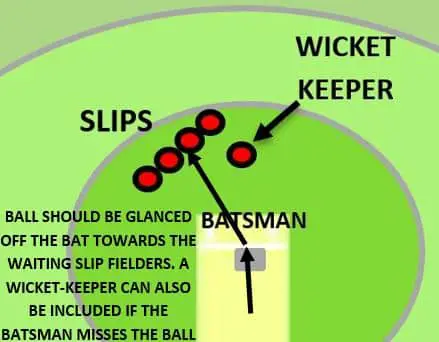
Image Credit: Cricketershub
There are a ton of other drills available! Your instructors will undoubtedly have a ton more suggestions! You should practice as much as you can if you’re serious about getting better at catching! It’s the only path to improvement!
Get Into A Balanced Position As The ball Is About To Be Bowled
Before the ball is bowled, you should always try to align your body in a balanced manner. Positioning yourself in this manner is the starting point for every movement you make when the batsman hits the ball! When the ball is hit, it will be easier for you to react swiftly and launch or fling a hand in its direction if you’re well-balanced.
It is advisable to ensure that your weight is equally distributed over both feet while standing with your feet around shoulder-width apart. I advise you to press up onto the balls of your feet and gently bend your knees while the ball is being bowled.
This is a great explosive position that allows you to launch yourself swiftly toward the ball! To be ready to move fast if a catch is made, your arms should also be slightly bent. Many players like to take breaks between deliveries by resting their hands on their knees. As long as you take them out before the ball is bowled, this is acceptable! Oh, and when the bowler is running in, please make sure you keep your hands out of your pockets! I’ve witnessed a lot of fielders receive harsh criticism from their teammates for doing it!
When fielding near the wicket or any place inside the inner ring, it is very crucial to assume the balanced stance that I just described. It’s not necessary to stand with your feet wide apart and your knees bent when fielding out on the boundary. You can stand more erect; just make sure you’re focused and prepared to move quickly in the direction of the ball if it approaches you. Be ready for the ball to come your way at all times!
Keep Your Eye On The Ball
I feel like I mention this tip a lot in my writing, but it is so crucial that I just can’t stop!
It’s crucial to make an effort to watch the ball into your hands if you want to regularly catch it. By keeping a close eye on the ball in this way, we can learn more about its trajectory and speed as it travels through the air. Then, with this knowledge, we may position our hands to catch the best possible catch!
Try your hardest to concentrate on observing the ball go straight into your hands throughout your practice sessions. This improves our ability to focus, and the more you do it, the more natural it will feel. Many players have a habit of turning away from the ball as soon as it approaches them halfway! You’ll be far more likely to take a challenging catch if you can train yourself to watch it for a little while longer!
Tips To Improve Your Catching Skills: Try To Improve Your Reaction Time
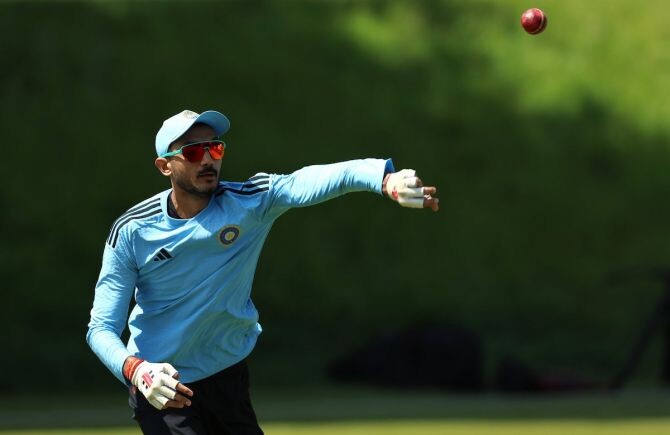
Although most of the time our reaction time to events in sports is innate, there are a few things we can do to accelerate our pace on the cricket pitch.
The simplest method to make sure you’re responding to the ball fast enough to catch it is to practice close catching, as I mentioned in a previous section. Your reflexes during a game will improve if you become accustomed to catching the ball during practice.
One type of practice I used regularly was as follows:
- Get a partner and stand opposite them, around 5–10 meters away. Then turn your back on them so you’re facing the opposite way!
- Your partner should be armed with a tennis ball. They should count from 1 to 3, and on 3, they should throw the ball towards you.
- When you hear the count of 3, you can quickly spin around and attempt to catch the ball.
This is an excellent practice because it’s very easy, but it does require you to find the ball and respond to it very fast! Asking your companion to throw the ball a little bit faster will provide you with an added challenge!
Practicing this technique with a hard cricket ball is not advised, as you run a higher risk of being struck when facing the ball. Ask your partner to toss the ball away from your body if you choose to carry out the drill with a hard ball.
Tips To Improve Your Catching Skills: Use The Orthodox Cup and Reverse Cup Catching Method
When my coach shared this idea with me, it completely changed my young cricket experience and gave me a lot more confidence when catching the ball. Still, I’m amazed at how many adult players are unaware of the distinction between conventional and reverse cup-catching techniques! The images that follow should make everything obvious! Placing your palms together and pointing your fingers downward is the traditional cup way of catching. The opposite is the reverse cup method, which calls for you to tip your fingers upwards and place your palms together!
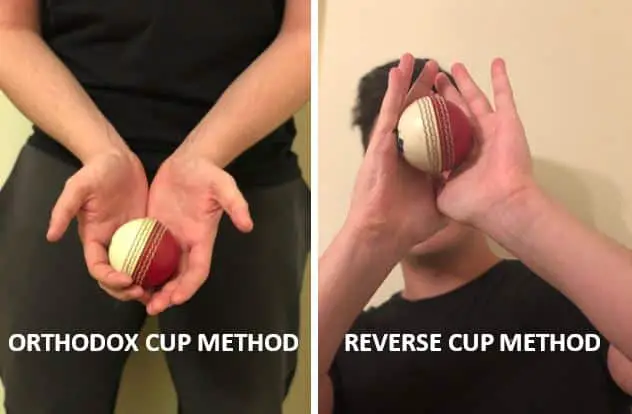
The height at which the ball reaches you should determine which hand position you should adopt. I prefer to abide by the following fundamental guidelines:
When the ball reaches you and it’s higher than your stomach, you should use the reverse cup method to grab it, pointing your fingers skyward. To make this an even more comfortable catch, you can squat down and gently bend your knees if necessary.
Using the traditional cup approach and aiming your fingers down toward the ground, you should make the catch if the ball reaches you lower than the height of your stomach.
When you practice catching and fielding, concentrate on accepting your catches in this manner. Getting someone to stand directly across from you and throw balls at varying heights in your direction is a wonderful way to practice. Request that they toss some of the balls about your midsection, some up high toward your head, and some low toward your feet. This is an excellent way to become familiar with the various cup ways that you will need to employ because of the varying ball heights!
Use The Hard Ball As Often As Possible In Your Practice Sessions
You should, in my opinion, make sure you’re routinely practicing catching with a truly hard cricket ball! Some players get intimidated by the ball’s toughness, which deters them from making catches! Particularly after the batsman has struck the ball with such vigor!
Practice is the only method to become accustomed to the impact and gain comfort when catching the hard cricket ball! Of course, you can practice with various balls (wind balls, tennis balls, etc.), but if you can, I’d strongly advise practicing with a hard ball.
As I’ve mentioned in numerous other pieces, I always think that the situations you’ll face in a game should be just as challenging during your practice sessions. Practice with the hard cricket ball to ensure you are fully ready for real-life scenarios!
Practice One-Handed Catches
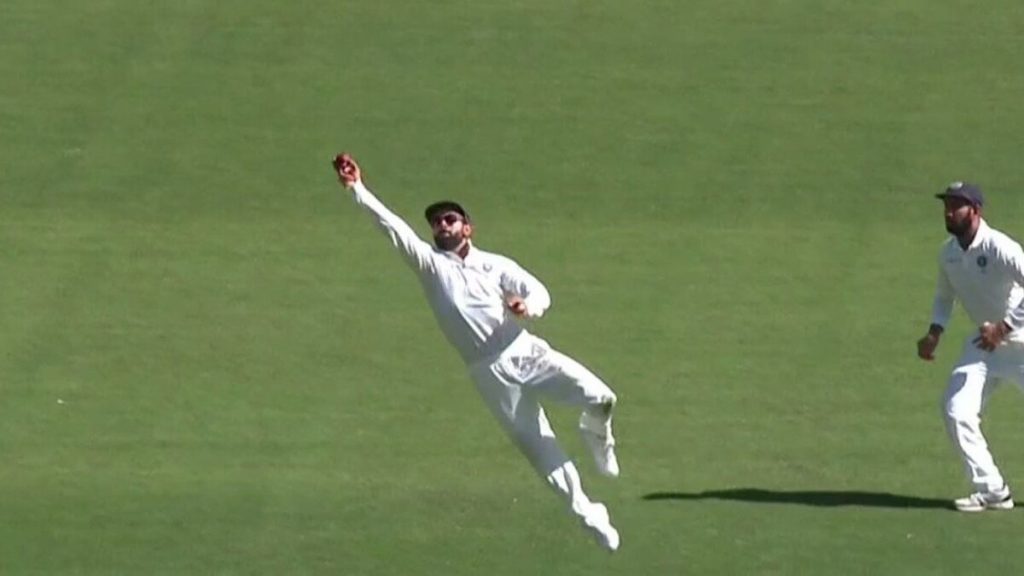
During a game, there will be moments when the ball travels at such a high speed and challenging angle that you are unable to position yourself to catch it with two hands. Fielders may occasionally have to leap about in an attempt to make an even more impressive one-handed catch!
I would advise practicing these catches as well, since you might need to make one during a game! These incredible athletic catches are something that all of the top fielders in the current game can make appear simple! Fortunately, there are a few simple methods to put them into practice! Here’s an illustration of a drill that might be useful:
- Get a partner to stand opposite you around 5 meters away
- Have them throw the ball towards you at a decent pace. But tell them to make sure that they place the ball far away enough from you that you can only catch it one-handed.
- They should vary the direction in which they throw the ball. Testing you low to your left and right, but also high above your head on both sides.
- Because the ball is being thrown quickly, it will require you to react quickly to get your hand in position to catch the ball.
You will feel more at ease the more times you practice taking catches like this one! It’s also a really enjoyable pastime. It was always a good laugh and a fantastic way to get some energy out when I would dive around in practice and try to imitate some of the classic diving catches!
Players in other sports, such as American football, frequently have to make one-handed receptions. They will therefore continuously drill them throughout practice, frequently catching over 100 balls in the process! I want to approach cricket similarly.
Of course, practicing to catch 100 balls with one hand isn’t always possible. But if you’re truly interested in enhancing that aspect of your game, you ought to try dedicating ten to fifteen minutes to one-handed catch drills!
Get Positioned Underneath The High Ball As Quickly As Possible
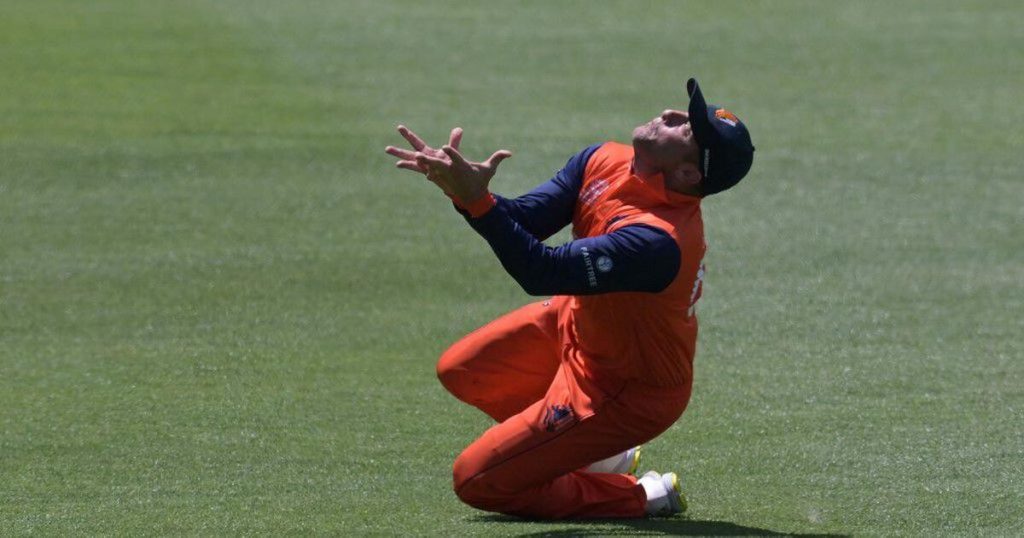
When making high catches, you have to arrive at the ball’s landing spot fast and position yourself to make the catch. You will be much less balanced when the ball gets to you if you are unable to position yourself appropriately beneath it. This makes catching much more difficult! Of course, there are instances in which it isn’t feasible to place your feet so that they are in a balanced position beneath the ball before making the catch. There are moments when the ball is simply too far away! However, we should always try to position ourselves exactly underneath the ball whenever possible.
It takes practice to become proficient at anything like this. You’ll have to gain the ability to evaluate the ball’s speed and distance as soon as possible, and experience will teach you this!
Get a coach or a partner to hit a ball high in the air away from you as a great method to practice getting into position nice and early. The next step is for you to follow the ball as it flies through the air and make the catch. There are a few factors to keep in mind in this scenario:
Always keep your eyes on the ball. There is no other way to determine its flight and speed with any degree of accuracy.
Proceed swiftly in the direction of the ball so that you are in the general vicinity where you believe it will land.
You can slow down and take more precise steps as you get closer to where you believe the ball will land before positioning your hands to make the grab.
It goes without saying that if the ball is far away, you could have to dive and dash for it without having a chance to stop and regroup! However, with time and expertise, you’ll be able to tell when this is necessary!
If you find it difficult to catch high, make sure you practice several times a week. Having a few successful catches under your belt is the only way to gain confidence when playing under the high ball!
Use Your Hands To Soften The Blow From The Cricket Ball
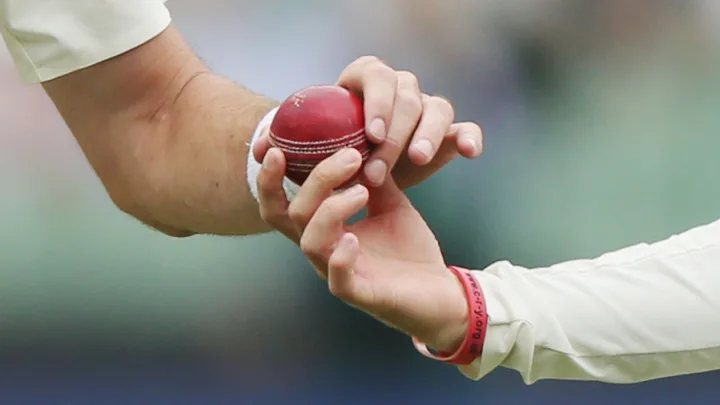
This kind of technique for catching increases the likelihood that you will drop more balls than you catch! You should aim to move your hands as the ball makes contact with them to cushion the blow, as opposed to sticking them out and letting it hit them. This motion assists in reducing the force of the blow!
Let’s examine a few instances:
If you’re taking a high catch, where the ball has been hit high in the air – as the ball descends toward you, you should try to get yourself under it as soon as possible and set up your hands in a suitable catching stance. I prefer to hold my hands around 10 centimeters in front of my chin in the reverse cup posture. When the ball gets close to your hands, turn your head to one shoulder and bring your hands to the other shoulder. This implies that the ball does not need to slow down as rapidly when you pull your hands toward your body. This implies that your hands won’t hurt as much! To prevent the ball from inadvertently hitting your face, cock your head slightly to the side as you make the catch!
If you’re taking a low flat catch, where the ball has been hit directly towards you – Your goal needs to be to achieve equilibrium. When assessing the height of the ball, I like to squat down a little! We’ll use the situation where the ball is approaching you at hip height. You should draw the ball in toward your body as soon as it makes contact with your hands.
When catches are made in this manner, the ball does not slow down as rapidly. The thing that hurts you the most is when you catch the ball and keep your hands in the same spot because it will slow down instantly! A nice strategy to lessen the blow is to bring your hands in towards you as you take the catch!
Tips To Improve Your Catching Skills: Remember to wear the right headgear when the sun is out!
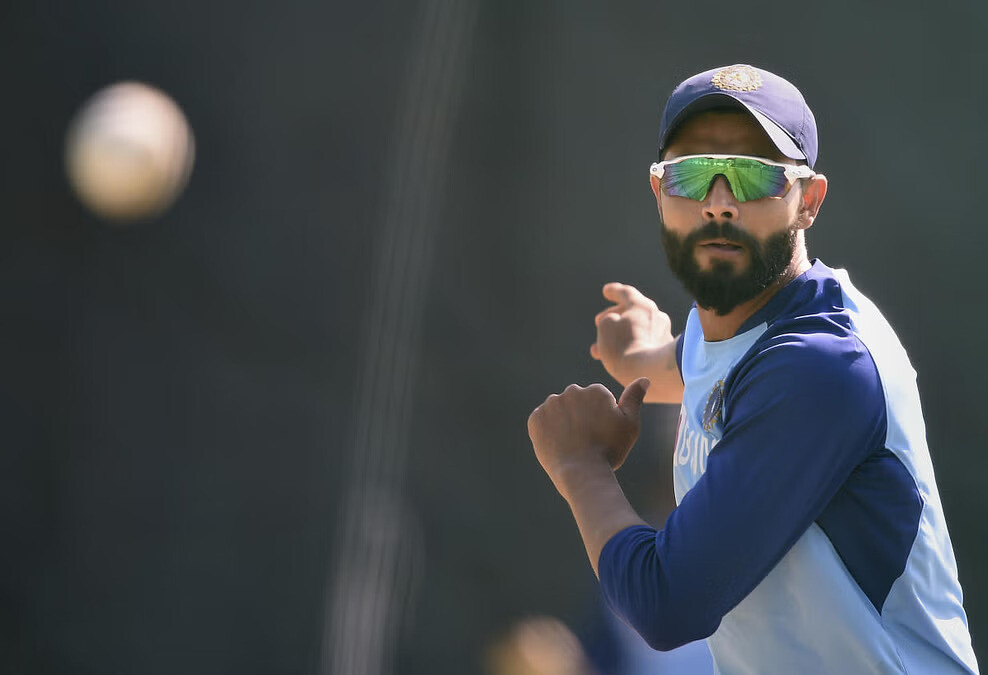
Sometimes, when fielding, we’ll need to wear a cap or sunglasses so that we can always keep our eyes on the ball!
Most of you have probably attempted to make a high catch when the ball flies across the sun’s path. You may find it almost tough to catch the catch in the sunshine!
You should always have some sunglasses, a cap, or a cricket hat in your kit bag to help with this! I like to use a combination of these, and I usually remember to pack a cap and sunglasses for games in case the sun comes out! These things help you cope better with brighter days and might be the difference between you taking a simple catch and losing it!
Develop A Way To Concentrate Your Mind Before Each Delivery
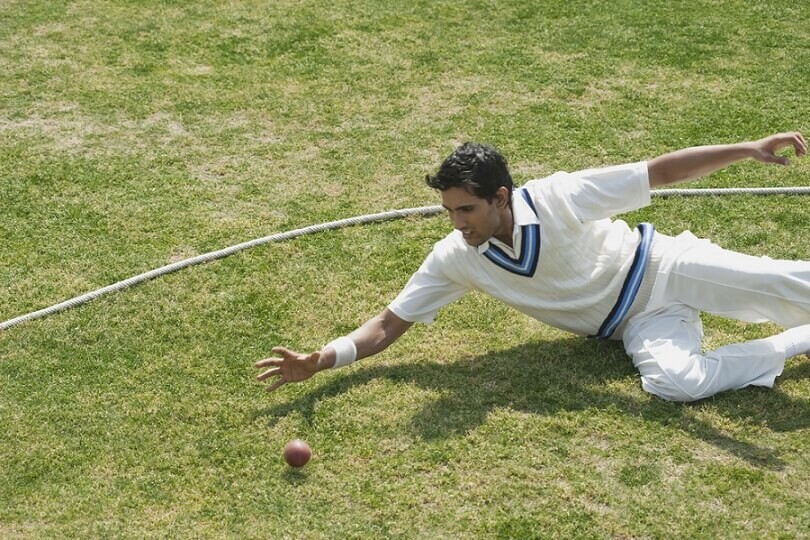
One of the main reasons for failed receptions in the field is lapses in concentration. You’ll be far less likely to take the catch if you let your thoughts go for a moment and begin planning your lunch, just as the ball is rapidly approaching you!
The most proficient fielders learn strategies for improving their focus throughout extended fieldwork sessions. After the delivery is bowled, some people like to walk away and clear their heads before returning to their fielding posture and focusing again, while others like to talk to themselves and remind themselves to monitor the ball!
Since every person is unique, pick a solution that works for you and implement it. It is crucial to approach every ball as though it were destined for you! I make an effort to approach each ball as a chance to influence the outcome of the game while I’m fielding! It will be much easier for you to respond more quickly if you can focus yourself, as the batter is going to receive the ball.
Tips To Improve Your Catching Skills: Work On Boundary Catches With Your Teammates
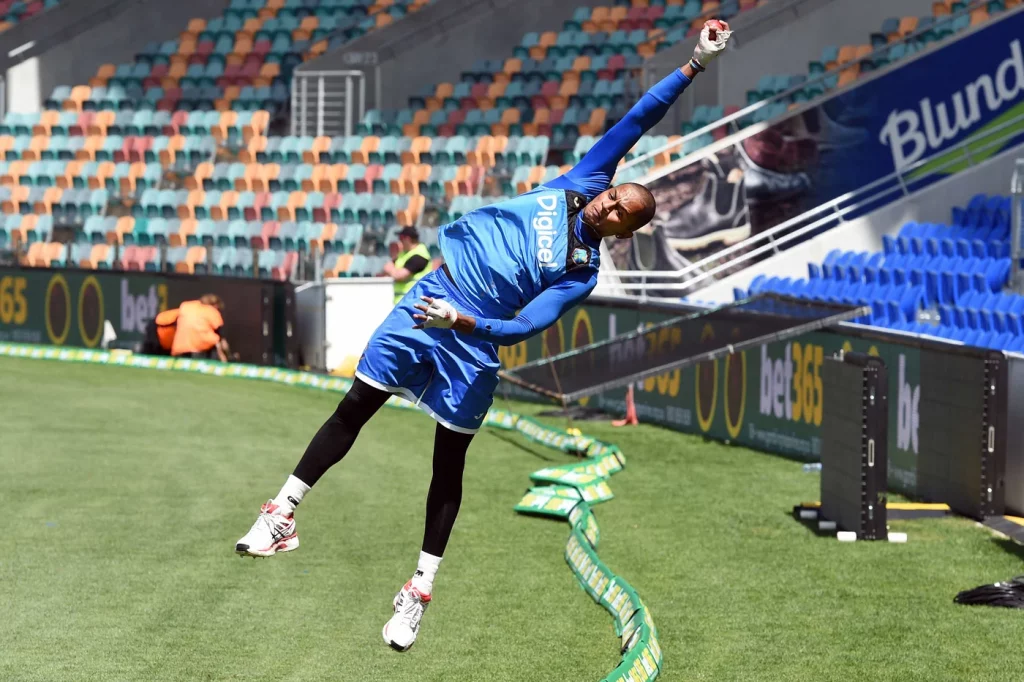
Those of you who follow cricket regularly will have noticed a significant rise in multiple-player catches on the boundary over the past five years.
You must not step on or over the boundary rope to perform a catch and get the batter out. Fielders occasionally take catches close to the boundary, but their speed carries them over the rope! Should this occur, the batsman will receive a score of six. Professional teams train their boundary fielders to operate in pairs to prevent this from occurring!
This implies that a player can pass the ball to a teammate who should have set up nearby as soon as they capture the ball and are unable to stop themselves from going beyond the boundary rope! After that, this fielder will finish the catch on their behalf.
There is a lot of teamwork involved in this catching technique, so it will surely need some practice! Tell your coach if you think it’s worthwhile, and they should be able to arrange a little fielding drill for you to practice.
So, this was all about the Tips To Improve Your Catching Skills.

